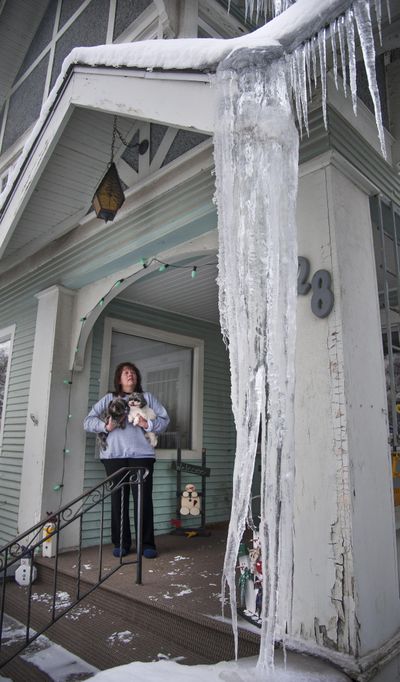Winter freeze leads to great icicles

Icicles are a common winter sight in Spokane, but this year’s crop of frozen daggers is the best in recent memory.
A near-perfect series of weather conditions has allowed icicles to form not only on old houses where you would expect to find them but also on newer homes with good insulation.
Even some unheated garages have a few icicles this year.
But enjoy the pointy formations while you can. Moderating temperatures during daylight hours this week could cause the icicles to come unhinged.
Experts say that makes them dangerous and it’s a good idea to give wide berth to the large, heavy ones.
One of the most common ways icicles form is when a thick layer of snow covers roofs, providing an insulating blanket for the top of the building.
That allows whatever warm air is coming from the roof to melt the lowest layer of snow, allowing it to drain to the edge of the roof.
There, the water freezes, but in doing so, something magical occurs: The ice elongates into stalactite-like shapes as the water drips downward.
A sunny day can trigger icicle formation, but it would be limited to portions of the building with exposure to the winter sun.
Jessie Wuerst, spokeswoman at Avista Utilities, said she checked with the company’s engineers, who said even well-insulated homes may see icicles, especially if the sun comes out.
Todd Carter, forecaster for the National Weather Service bureau in Spokane, said, “You are going to get some heat loss in a roof no matter how well insulated you are.”
Scientists who have studied icicles say that as the water freezes it releases a layer of warm air that provides an invisible sheath around the icicle. The water can then drip downward on the outside of the icicle before encountering enough cold air to freeze it, according to a 2011 article on the Physics Buzz blog at physicscentral.com.
The sheath of warmer air gets progressively thinner as the water drips downward, which causes the classic icicle taper.
Windless weather helps icicles grow by keeping the warm air sheath in place. Sometimes the tip of an icicle is concave under magnification.
Ice dams, which are horizontal masses of ice, also can form at the edge of roofs, especially those with overhanging eaves. They can cause damage or redirect water underneath roofing to cause a leak.
Some homes in Spokane are equipped with heat cables at the edges of the roofs to prevent ice from building up.
Heather Hart at Spokane Roofing Co. said her company is getting a lot of calls from residents who have ice dams.
However, there are so many repairs still to be completed from the November windstorm that the company has been unable to help out with the unwelcome ice.
She said breaking up the ice dam or using de-icer are about the only ways of dealing with the problem. Trying to break hard ice clinging to shingles or flashing risks causing damage.
The icicle weather arrived when nearly 19 inches of snow fell between Dec. 16 and Christmas Eve, and then the weather turned distinctly colder.
The region is due for a bit of a break in the cold. Highs are likely to reach the middle 30s on Tuesday and Wednesday before going to 33 on Thursday and Friday.
There is a chance of snow and rain Tuesday night through Wednesday and again later in the week. Accumulations of 1-2 inches are possible.
An air stagnation advisory has been extended through 10 a.m. Thursday for areas below 3,000 feet in elevation because higher air pressure is expected to continue hovering over the Northwest.
The higher air pressure is expected to block any strong storms.